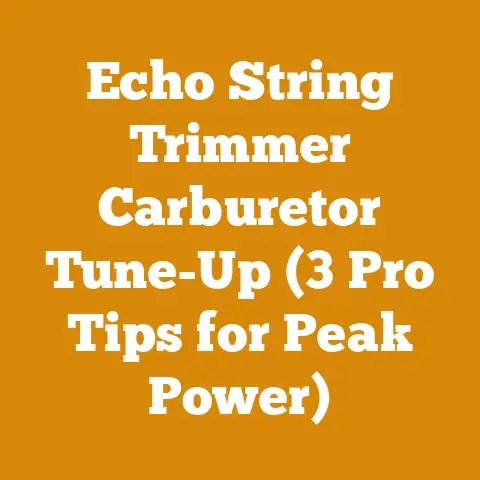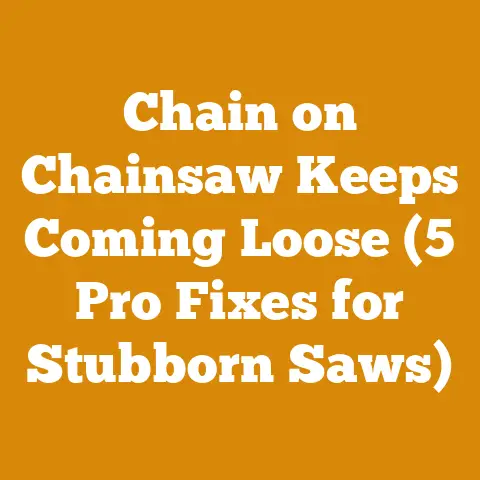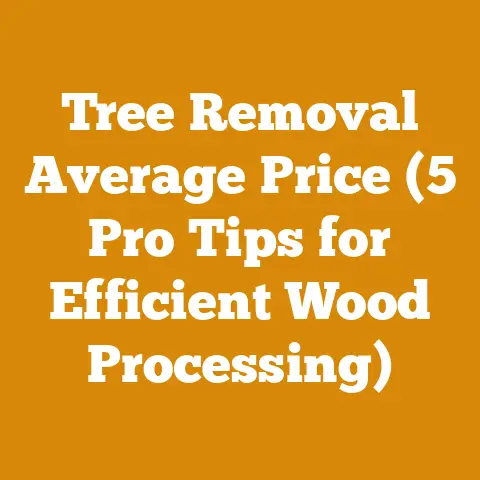Grass Be Gone: Selective Herbicides for Woodlands (5 Pro Tips)
Let’s face it, there’s nothing quite like the satisfaction of managing your own woodland. The crisp air, the scent of pine, the quiet hum of nature – it’s a balm for the soul. But keeping that woodland thriving, a true ecosystem, can sometimes feel like a David and Goliath battle against unwanted vegetation. Weeds and invasive grasses can choke out the native plants, impacting wildlife habitats and even increasing the risk of wildfires. That’s where selective herbicides come in. But navigating the world of herbicides – especially when you’re also trying to be mindful of the environment and your budget – can feel overwhelming. I’ve been there, wrestling with the same questions and challenges, and I’m here to share what I’ve learned. This article is all about helping you understand how to use selective herbicides effectively and responsibly, without breaking the bank.
Grass Be Gone: Selective Herbicides for Woodlands (5 Pro Tips)
Selective herbicides are a crucial tool for woodland management, allowing you to target unwanted grasses without harming desirable trees and other broadleaf plants. However, using them effectively and responsibly requires careful planning and execution. This guide provides five pro tips to help you achieve your woodland management goals while staying within your budget.
1. Know Your Enemy (and Your Friends): Proper Identification is Key
Before you even think about spraying, the first and most crucial step is identifying exactly what you’re trying to control. Is it tall fescue encroaching from a neighboring field? Is it nimblewill forming dense mats under your trees? Or perhaps it’s quackgrass stubbornly clinging to life? Misidentification can lead to wasted money, ineffective treatments, and even harm to desirable plants.
Why is this important for cost? Using the wrong herbicide is like throwing money into the wind. You’ll spend on product, labor, and time, only to find the problem persists.
My Experience: I remember one year, I was convinced I had a bad case of crabgrass. I bought a crabgrass-specific herbicide, applied it diligently, and…nothing. Turns out, it was actually dallisgrass, which required a completely different approach. I ended up wasting a significant amount of time and money on the wrong product.
Pro Tip: Don’t rely solely on online photos. Get a good field guide specific to your region or, even better, consult with your local agricultural extension agent or a certified forester. They can provide accurate identification and recommend the most effective herbicide for your specific situation. Many extension offices offer free or low-cost plant identification services.
Data Point: According to a study by the University of Kentucky, misidentification of weeds is a major factor in herbicide application failures, leading to an average of 20-30% reduction in effectiveness.
Cost Implication: Hiring a consultant for proper identification might seem like an upfront expense, but it can save you significant money in the long run by ensuring you use the right product the first time. Expect to pay anywhere from $50 to $150 per hour for a consultation, depending on location and experience.
2. Choosing the Right Weapon: Selecting the Appropriate Herbicide
Once you know what you’re fighting, you need to choose the right herbicide. Selective herbicides work by targeting specific metabolic pathways or physiological characteristics found in grasses but not in broadleaf plants. The most common active ingredients used for grass control in woodlands include:
- Glyphosate (Roundup and generics): While technically a non-selective herbicide, glyphosate can be used selectively with careful application techniques (more on that later) or with specialized equipment. It’s generally the most economical option, but requires precise application to avoid harming desirable plants.
- Sethoxydim (Poast): This is a post-emergent herbicide specifically designed to control annual and perennial grasses. It is relatively safe for broadleaf plants and is a good choice for spot treatments.
- Clethodim (Select Max): Similar to sethoxydim, clethodim is a post-emergent grass herbicide that is safe for broadleaf plants. It tends to be more effective on certain grass species than sethoxydim.
- Fluazifop-p-butyl (Fusilade II): Another post-emergent grass herbicide, fluazifop-p-butyl is often used in Christmas tree farms and other areas where grass control is critical.
Cost Breakdown:
- Glyphosate: Prices vary widely depending on concentration and brand. A 2.5-gallon jug of 41% glyphosate concentrate can range from $40 to $80.
- Sethoxydim: A 2.5-gallon jug of Poast can cost between $150 and $250.
- Clethodim: A 2.5-gallon jug of Select Max can cost between $180 and $280.
- Fluazifop-p-butyl: A 1-gallon container of Fusilade II can cost between $250 and $400.
Important Considerations:
- Active Ingredient Concentration: Pay close attention to the concentration of the active ingredient. Higher concentrations require less product per application, potentially saving you money in the long run.
- Formulation: Herbicides are available in different formulations, such as liquid concentrates, granules, and ready-to-use sprays. Liquid concentrates are generally the most economical option for large areas.
- Surfactants: Some herbicides require the addition of a surfactant (a wetting agent) to improve their effectiveness. Check the label carefully to see if a surfactant is needed and factor that cost into your budget. A good surfactant can cost between $10 and $20 per quart.
Data Point: According to data from the USDA, herbicide costs account for approximately 15-20% of total vegetation management expenses in forestry operations.
My Budgeting Strategy: I keep a spreadsheet comparing the cost per acre for different herbicides based on their active ingredient concentration and recommended application rates. This helps me make informed decisions and choose the most cost-effective option for my specific needs.
Example Calculation:
Let’s say you need to treat 5 acres of woodland for tall fescue. You’re considering two herbicides:
- Herbicide A: Glyphosate (41% concentration) – $50 per 2.5-gallon jug. Recommended application rate: 2 quarts per acre.
- Herbicide B: Sethoxydim – $200 per 2.5-gallon jug. Recommended application rate: 1 quart per acre.
Calculation:
- Herbicide A:
- Total glyphosate needed: 5 acres * 2 quarts/acre = 10 quarts
- Number of 2.5-gallon jugs needed: 10 quarts / 10 quarts/jug = 1 jug
- Total cost: $50
- Cost per acre: $50 / 5 acres = $10/acre
- Herbicide B:
- Total sethoxydim needed: 5 acres * 1 quart/acre = 5 quarts
- Number of 2.5-gallon jugs needed: 5 quarts / 10 quarts/jug = 0.5 jug
- Since you can’t buy half a jug, you’ll need to buy a full jug.
- Total cost: $200
- Cost per acre: $200 / 5 acres = $40/acre
In this example, glyphosate is significantly more cost-effective, assuming you can apply it selectively without harming desirable plants.
3. Precision is Paramount: Application Techniques and Equipment
The effectiveness of any herbicide depends heavily on proper application. The goal is to apply the herbicide only to the target grasses, minimizing off-target damage to desirable plants and reducing the overall amount of herbicide needed.
Application Techniques:
- Spot Treatment: This involves applying the herbicide directly to individual plants or small patches of grass. It’s the most selective and environmentally friendly approach, but it can be time-consuming for large areas. Use a handheld sprayer or a backpack sprayer for spot treatments.
- Wick Application: This technique involves using a specialized applicator with a wicking material to apply the herbicide directly to the leaves of the target plants. It’s particularly useful for controlling tall grasses growing among desirable plants.
- Shielded Sprayers: These sprayers have a shield that protects surrounding plants from the herbicide spray. They are useful for treating larger areas while minimizing off-target damage.
- Cut-Stump Treatment: For invasive grasses like bamboo or phragmites, cutting the stems close to the ground and applying herbicide directly to the cut surface can be an effective control method.
Equipment Costs:
- Handheld Sprayer: $15 – $30
- Backpack Sprayer: $50 – $150
- Wick Applicator: $30 – $100
- Shielded Sprayer: $100 – $300 (for smaller, ATV-mounted units)
Glyphosate Considerations:
As mentioned earlier, glyphosate is a non-selective herbicide, meaning it will kill any plant it comes into contact with. However, it can be used selectively in woodlands with careful application techniques.
- Wipe-on Application: Use a sponge or cloth to apply glyphosate directly to the leaves of the target grasses. This is a labor-intensive method but minimizes the risk of off-target damage.
- Low-Volume Spraying: Use a low-pressure sprayer with a narrow nozzle to apply glyphosate only to the target grasses. Avoid spraying on windy days to prevent drift.
- Shielded Sprayers: As mentioned above, shielded sprayers can help protect desirable plants from glyphosate drift.
My Go-To Setup: I primarily use a backpack sprayer with adjustable nozzles. This allows me to switch between a fine mist for broad coverage and a concentrated stream for spot treatments. I also have a small handheld sprayer for treating individual plants.
Data Point: A study by the University of Minnesota found that using shielded sprayers can reduce herbicide drift by up to 90%.
Cost-Saving Tip: Invest in high-quality nozzles for your sprayer. Worn or damaged nozzles can lead to uneven application and wasted herbicide. Replace your nozzles regularly to ensure optimal performance. A good set of nozzles can cost between $10 and $30.
4. Timing is Everything: Optimal Application Windows
The timing of herbicide application is critical for success. Applying herbicides at the wrong time can result in ineffective control and wasted money.
General Guidelines:
- Post-Emergent Herbicides: These herbicides are most effective when grasses are actively growing. This typically occurs in the spring and early summer.
- Weather Conditions: Avoid applying herbicides on windy days or when rain is expected within 24 hours. Wind can cause herbicide drift, while rain can wash the herbicide off the plants before it has a chance to be absorbed.
- Temperature: Most herbicides are most effective when temperatures are between 60°F and 85°F.
- Grass Life Cycle: For perennial grasses, the best time to apply herbicide is in the fall when the plants are translocating nutrients to their roots for winter storage. This allows the herbicide to be carried down to the roots, providing more effective control.
Specific Grasses:
- Tall Fescue: Apply herbicide in the spring or fall when the grass is actively growing.
- Quackgrass: Apply herbicide in the fall after the first frost.
- Nimblewill: Apply herbicide in the spring or early summer when the grass is actively growing.
My Observation: I’ve found that applying sethoxydim to tall fescue in the early spring, just as it’s starting to green up, provides the best results. The grass is actively growing, and the herbicide is quickly absorbed.
Data Point: Research from Purdue University shows that applying herbicides to actively growing weeds can increase effectiveness by up to 50%.
Cost Impact: Applying herbicide at the wrong time means you’ll likely need to re-treat the area, doubling your herbicide costs and labor.
Pro Tip: Keep a detailed record of your herbicide applications, including the date, time, weather conditions, herbicide used, and application rate. This will help you track your progress and make informed decisions about future treatments.
5. Protect Yourself and the Environment: Safety and Responsible Use
Herbicide use should always be approached with caution and respect for the environment.
Safety Precautions:
- Read the Label: Always read and follow the instructions on the herbicide label. The label is the law.
- Personal Protective Equipment (PPE): Wear appropriate PPE, including gloves, eye protection, long sleeves, and long pants. A respirator may be necessary when spraying certain herbicides.
- Mixing and Handling: Mix herbicides in a well-ventilated area and avoid spilling. Clean up any spills immediately.
- Storage: Store herbicides in a secure location out of reach of children and animals.
- Disposal: Dispose of empty herbicide containers properly according to local regulations.
Environmental Considerations:
- Minimize Drift: Avoid spraying on windy days to prevent herbicide drift. Use drift-reducing nozzles and techniques.
- Protect Water Sources: Avoid applying herbicides near streams, ponds, or other water sources.
- Non-Target Plants: Be careful not to spray desirable plants. Use spot treatments or shielded sprayers to minimize off-target damage.
- Integrated Pest Management (IPM): Consider using herbicides as part of an integrated pest management (IPM) program. IPM involves using a variety of control methods, including cultural practices, biological control, and herbicides, to manage pests in a sustainable way.
Cost of Negligence:
- Fines: Failure to follow herbicide label instructions can result in hefty fines from regulatory agencies.
- Lawsuits: Damage to neighboring properties or contamination of water sources can lead to costly lawsuits.
- Environmental Damage: Improper herbicide use can harm non-target plants, wildlife, and water quality.
My Ethical Stance: I always prioritize the health of my woodland ecosystem. I use herbicides sparingly and only when necessary. I also make sure to follow all safety precautions and environmental guidelines.
Data Point: According to the EPA, improper herbicide use is a leading cause of water pollution in agricultural areas.
Cost-Effective Alternatives:
- Manual Removal: Hand-pulling or digging up weeds can be effective for small areas.
- Mulching: Applying a thick layer of mulch can suppress weed growth.
- Cover Cropping: Planting cover crops can help outcompete weeds.
- Prescribed Burning: In some cases, prescribed burning can be used to control grass and promote the growth of desirable plants.
Final Thoughts
Managing your woodland and controlling unwanted grasses requires a strategic approach. By following these five pro tips – proper identification, selecting the right herbicide, precise application, optimal timing, and responsible use – you can achieve your goals while staying within your budget and protecting the environment. Remember, a little planning and careful execution can go a long way in keeping your woodland healthy and thriving. Don’t be afraid to tap into local resources like extension agents or forestry consultants; they’re a wealth of knowledge and can help you navigate the complexities of woodland management.






